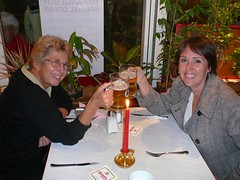 During the last phase of Judy's stay with us we went to Berlin for an extended weekend. I liked her description of it as a 'City of Contrasts'. It had a vibrant feel, lots of interesting things to do, cheap, good food, and the best beer I've ever tasted. In contrast, we spent many hours contemplating the dark side of Germany's history with visits to the Jewish History Museum, Berlin Wall monument, and Sachsenhausen concentration camp.
During the last phase of Judy's stay with us we went to Berlin for an extended weekend. I liked her description of it as a 'City of Contrasts'. It had a vibrant feel, lots of interesting things to do, cheap, good food, and the best beer I've ever tasted. In contrast, we spent many hours contemplating the dark side of Germany's history with visits to the Jewish History Museum, Berlin Wall monument, and Sachsenhausen concentration camp.We stayed in a suburb called Pankow, just north of the city centre, and in the former East Berlin. The apartment was perfect for the three of us - spacious, comfy, and close to the excellent public transport system.
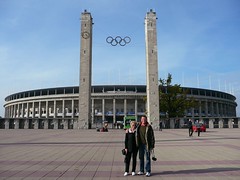 There is heaps to see in Berlin, and even though we had almost five days there, we could easily have stayed longer. The Olympiastadion (Olympic Stadium), built for the 1936 Summer Olympics and recently renovated for this year's FIFA World Cup, was high on Peter's list of sites to see. Unfortunately we picked the wrong day, arriving there on a match day meant we couldn't get inside to do the tour, but we got some nice pics from out the front.
There is heaps to see in Berlin, and even though we had almost five days there, we could easily have stayed longer. The Olympiastadion (Olympic Stadium), built for the 1936 Summer Olympics and recently renovated for this year's FIFA World Cup, was high on Peter's list of sites to see. Unfortunately we picked the wrong day, arriving there on a match day meant we couldn't get inside to do the tour, but we got some nice pics from out the front.Our other adventures included wandering through the beautiful Tiergarten park and getting caught up in a massive, but peaceful protest by union groups; enjoying a bratwurst sausage on Unter den Linden (and listening to Peter complain of indigestion for the rest of the afternoon); visiting Checkpoint Charlie with hundreds of other tourists; and Judy and I getting haircuts at groovy Berlin salons.
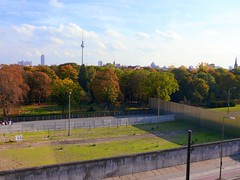 The Jewish History Museum was an interesting account of the Jewish people, their customs, lives, and their persecution over past centuries. Without realising it, we easily spent five hours wandering through the exhibits and were completely exhausted by the end of it.
The Jewish History Museum was an interesting account of the Jewish people, their customs, lives, and their persecution over past centuries. Without realising it, we easily spent five hours wandering through the exhibits and were completely exhausted by the end of it.It was fascinating to learn more about the Berlin Wall (1961-1989), which used to completely surround West Berlin, separating it from East Germany. There is a small portion of the Wall that remains as a monument. Kept completely free of graffiti, it doesn't resemble the typical images. The excellent museum nearby succinctly tells the story of the Wall's construction, impact, and fall.
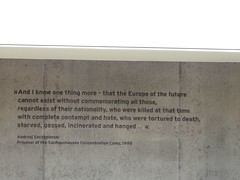 In Oranienburg, about 60km north of Berlin, is the Sachsenhausen concentration camp. Built in 1936, it was the first Nazi concentration camp. After the end of WWII it became a Soviet special camp until 1950. Although a small camp in comparison with others, 200,000 people passed through here between 1936 and 1945, only half of which survived. Sachsenhausen was also the administrative centre for all Nazi concentration camps, and a training centre for SS officers.
In Oranienburg, about 60km north of Berlin, is the Sachsenhausen concentration camp. Built in 1936, it was the first Nazi concentration camp. After the end of WWII it became a Soviet special camp until 1950. Although a small camp in comparison with others, 200,000 people passed through here between 1936 and 1945, only half of which survived. Sachsenhausen was also the administrative centre for all Nazi concentration camps, and a training centre for SS officers.It was the first time that any of us had been to such a place. It was an extremely difficult experience, but I think it was important to see. I found it incredible to contemplate the order with which these camps were established and run, and how people could treat others so disgustingly. Several buildings of the original camp remain today, and the public memorial and museum ensures the history is well preserved.
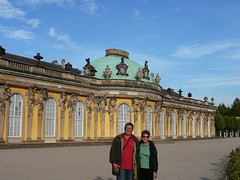 During our last day in the city we took a train down to Potsdam, the capital of the state of Brandenburg, and the location of the 1945 Potsdam Conference, where the allies met to decide the future of Germany and post-war Europe. It is also the site of the beautiful Sanssouci park and palaces, a UNESCO World Heritage Site.
During our last day in the city we took a train down to Potsdam, the capital of the state of Brandenburg, and the location of the 1945 Potsdam Conference, where the allies met to decide the future of Germany and post-war Europe. It is also the site of the beautiful Sanssouci park and palaces, a UNESCO World Heritage Site.Our long weekend in Berlin was the last little holiday we did during Judy's stay with us. I think we all enjoyed it immensely and it was a real highlight (among many!). Jude is now on her way back to Oz, and is in Hong Kong as I type this. It was wonderful for us to spend nine weeks with her. Thankfully it wasn't too hard to say goodbye, because we will be seeing her back in Adelaide in about four weeks time!
See all of our Berlin photos on Flickr.


